|
I. Introduction: Definition of Obesity and Types of Diabetes简介:肥胖的定义和糖尿病的类型
迄今为止,肥胖和糖尿病是两个通常在病理学讨论中并列的概念。关于肥胖的讨论的第一个记录可以追溯到旧石器时代的石器时代,这是从今天起大约2.5万年前的一个时代。直到2013年[2],当美国医学协会将其列为现代美国社会中最常见和最严重的健康问题时,肥胖并不被认为是一种有问题的疾病。随着人们的生活方式和饮食习惯越来越不平衡,肥胖的普遍现象在全球范围内以越来越不平衡的速度在全球范围内日益流行。一个关键原因是肥胖增加了其他更严重疾病的可能性,例如作为心脏病,某些类型的癌症和2型糖尿病(我们将进一步讨论)。[3]另一个原因是,根据1999年卫生部联合健康调查股进行的一项研究,肥胖的流行速度正以前所未有的速度在世界范围内加速作为一种流行病(图1)。[4]我们可以观察到,肥胖患病率的爆发速度和女性比男性更加肥胖。最近,在21世纪,另一项研究在“柳叶刀”上展示了全球肥胖患病率的趋势。它强调,就在2010年的一年内,这两种疾病的负面影响是如此致命,以致导致许多人死亡。事实上,据估计,这两人死于超过350万名患者,死亡病例数与糖尿病和肥胖患者总数的比例约为3-9%。大约3%至8%的全球患者患有残疾调整生命年,这表明肥胖和超重的后果对于最终没有死亡的患者。
To date, obesity and diabetes are two concepts that are often juxtaposed inpathological discussions. The first record of the discussions about obesity can be traced back to the Paleolithic Stone Age which was an epoch of about 25 thousand years ago from today. Obesity was not considered a problematic condition of sickness until 2013[2] when the American Medical Association listed it among the most common and serious health problems in the modern American Society. The widespread phenomenon of obesity has continued to grow increasingly epidemic across the globe at a rate that was unprecedented, as the lifestyle and the eating habit of people were increasingly unbalanced.One key reason is that obesity increases the possibility of other more serious diseases, such as heart disease, acertain type of cancers and type 2 diabetes (which we will discuss it further).[3] Another reason is the prevalence speed of obesity is accelerating around the world at an unprecedented rate as an epidemic disease, based on a research conducted by Joint Health Surveys Unit onbehalf of the Department of Health in 1999 (Figure 1).[4] we can observe that the explosive speed of obesity prevalence and more women than men become obese. More recently, in the 21 century, there was another study in The Lancet demonstrated the global trend of obesity prevalence. It emphasized that just in one year back in 2010, the negative impact of both diseases were so fatally that they contributed to a lot of the deaths of many. In fact it was estimated that the two were responsible for over 3.5 million patients passing away, and the number of death cases was about 3-9% in proportion to the total number of patients that had diabetes and obesity. About 3 to 8% of the global patients develop disability-adjusted-life-years, which showcasedthe aftermath of obesity and overweight on patients that did not eventually decease.
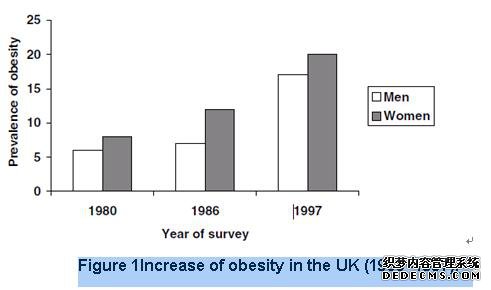
Obviously, the feature of obesity is over-weight, that is why the definition of obesity generally is a therapeutic situation where the accumulated excess amount of body fat might be detrimental to human health.Body mass index (BMI), (Table 1)[4]using anequation dividing a person's weight by the square of the person's height, is a standard value to classify the obesity. Some East Asian countries like China and Japan use lower standard.[4]
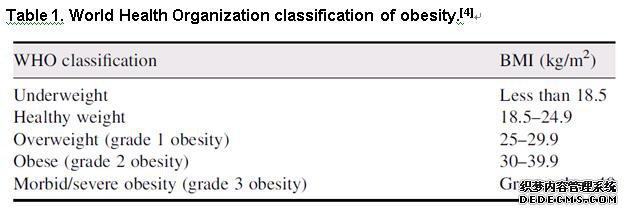
The spread of obesity has been increased by many factors as indicated in the table, at a rate that was much faster compared to that of the last century.One of the hypothesis of the increase in patients’ diabetes was attributed to errors of bodily functions in particular to metabolism.The person that introduced such hypothesis also challenged long-established idea that kidney deposit is one of the major causative factor of obesity. Type 1 diabetes usually means that the state of the patient's body cannot produce sufficient insulin because of failure in the immune system, which mistakenly eliminated insulin-producing cells, meaningthat their bodies cannot defend patients from the harm of viruses, invasive substances and bacteria that are incongruent with the functioning of human body.
The spread of obesity has been increased by many factors as indicated in the table, at a rate that was much faster compared to that of the last century. One of the hypothesis of the increase in patients’ diabetes was attributed to errors of bodily functions in particular to metabolism. In the meanwhile, the diabetes was hard to be diagnosed since their characterizations are not so obvious.In the history, Thomas Sydenham,the person that introduced such hypothesis also challenged the long-established idea that kidney deposit is one of the major causative factor of obesity[1], as well as another epidemic disease, diabetes.That is true since diabetes is such a situation wherethe glucose in your blood, also called blood sugar, is too high.
Besides some special cases, there are mainly three types of diabetes: type 1 diabetes, type 2 diabetes, and gestational diabetes. (A) Type 1 diabetes used to be called juvenile diabetes.Type 1 diabetes usually means that the state of the patient's body cannot produce sufficient insulin because of failure in the immune system, which mistakenly eliminated insulin-producing cells, meaning that their bodies cannot defend patients from the harm of viruses, invasive substances and bacteria that are incongruent with the functioning of human body.[6] (B) Type 2 diabetes is the most common type of diabetes to date. In type 2 diabetes, however, the body still can produce insulin at a normal stage. The problem here is either insulin is not sufficient or our body fails to respond it (insulin resistance), resulting in the high level of glucose in the blood. In contrast to type 1 diabetes, the most of type 2 diabetes patients don’t have to take adaily dose of insulin to control the level of glucose.[6] The number of people who get type 2 diabetes is rapidly increasing worldwide which can’t be ignored anymore.[7](C) As the name suggests, gestational diabetes is defined as diabetes that happens forthe first time in pregnancy. Women who get this type of diabetes will develop a resistant to insulin thus to have a build-up glucose.
II. Type Two Diabetes: Symptoms and Consequences
The commonest symptoms of type 2 diabetes areinsidious onset oftiredness, thirst, polyuria,weightloss, pruritus vulvae or balanitis; the patients are usually overweight or obeseand C-peptide detectable while havingno ketoacidosis.[6]The diagnosis of type 2 diabetes have been subjected to failure for years, and there has been a lot of cases of under-diagnosis as well as complete inability to diagnose this disease among patients,even though they may be carrying such a serious problem. It was because the patients themselves were inclined to disregard insidious symptoms of this disease. [8]
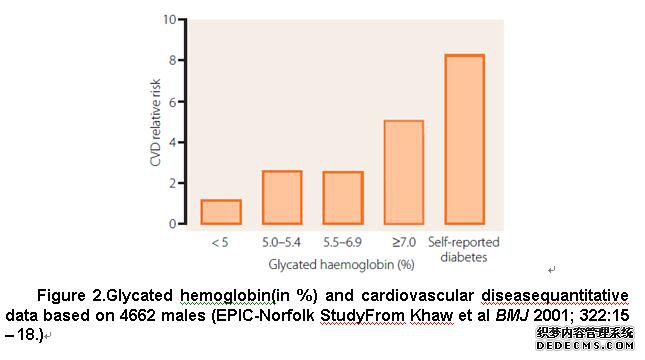
Same as all the types of diabetes, the consequences of type 2 diabetes generally arediabetic complications.The mostfatal complication is cardiovascular disease.A considerable amount of epidemiological studies have claimed that there were apparently objective evidence of the positive correlation between glycemiaand macrovascular disease in a community (Figure 2).[6]There are many other serve diseases such as kidney disease (caused by damaging small blood vessels), eye disease (can damage vision even provoke blindness), nerve damage (causing troubles in digestion and urination) and so on.[6]
The serious consequences are promoting people to pay more and more attention to this chronic type 2 diabetes.
III. Intense Link between Type Two Diabetes and Obesity
As one of thesymptoms of type 2 diabetesis that the patients are usually overweight or obese, some questions should be naturally raised that whether diabetes are connected to cases of obesity? If so, is there any valid evidence?
The Answers are yes.
Firstly, there is a lot of data evidence. As early as 1978, West has demonstrated that the upsurge of popularity of type 2 diabetes have been associated with a strong trend of obesity that was increasingly prevalent in a group of people[9]Amongthe same populations,there's also been clear evidence that the risk of getting diabetes will be higher among patients whose problems of obesity were already well proven. The data-value from Health Professionals follow-up study regarding men and the data of women from the Nurses’ Health Study have graphically represented how the increasing propensity of type 2 diabetes Is followed by the increased popularity of obesity Showing a positive correlation between them (Figure 3).[4] At the meanwhile, the data curve showed that for women, the risk of diabetes increases faster than men when the BMI is at the same stage. So obese women are more sensitive to getting type 2 diabetes.
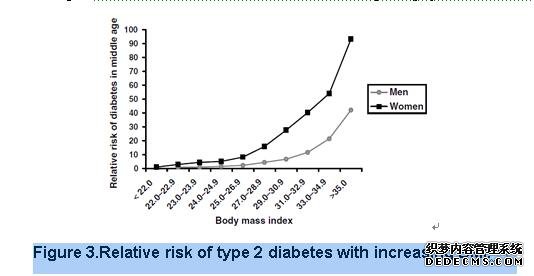 #p#分页标题#e# #p#分页标题#e#
Secondly, there is also a biological link, which is the fundamental reason, between the type 2 diabetes and obesity. In 2001, Lazar reported on Nature that resistin is a potentialhormone linking obesity to type 2 diabetes,[10]which was a major breakthrough in the relationship between type 2 diabetes and obesity. After 15 years’ development, the pathophysiology of obesity-inducedtype 2 diabetes has shown the complicated mechanismsin a clearer manner. Among different hypothesis, there have been two major theories that expounded on the causative relationship between excessive amount of fat and its consequential impact on the function of metabolism related to impaired glucose. The first one is ‘Randle’s cycle’,whichelucidates the reversibly application of the associable correlation between glucoseoxidation and fatty acid oxidation. Another one is the ‘ectopic fat storage hypothesis’, which is based on the impairedinsulin effect as a result of deposition of lipids that takes place in insulin-target tissues. Both researchers coinedthe well-known ‘lipotoxicity theory’ and propose a realisticframework of metabolic mechanism in whichlong termstorage of excessive fat increases with lowering ofinsulin secretory capacity of beta cells and insulin resistance.[4]
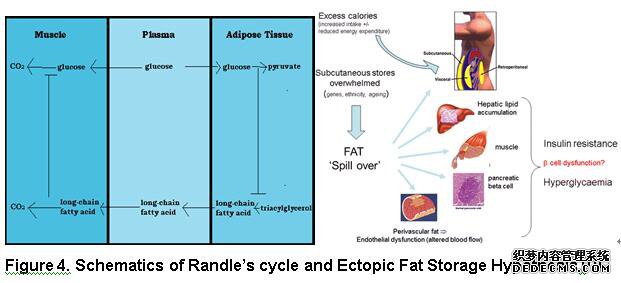
Last but not least, alot of factors such as age, ethnicity, physical activity, dietary composition, duration of obesity and even social networkwill affect the relationship between obesity and diabetes in the complex of internal mechanism. The meaning of this is to explain the reasons why 1) one-fifth of patients withtype 2 diabetes do not suffer from obesity and 2) even patientsbelonging to the top risk-group characterized by high BMIscan overcome type 2 diabetes.[4]
IV. Obesity and Type Two Diabetes in Modern Society
In the modern society, obesity and type 2 diabetes have become two serious and aggravatingproblems and thesocial costs incurred are growing increasinglyhuge.
Here are some vivid statuses:in Africa, over three-fourth of deaths caused bydiabetes are among people below 60;Europe suffers the highest popularity of diabetes in terms of the population of children with type 1 diabetes; in the Middle East and North Africa,about one-tenth of the adult populationhas diabetes, but this is surpassed by the figures of South-East Asia, in which about 50% of the population havediabetes undiagnosed; In the Western Pacific, almost 140 millionadults suffer the effect of diabetes, charting at the first place amongtheaforementioned regions.[15]
A paper published in The Lancet showed that, the upsurge of obesity among grown-ups in developed countrieshas decreased since 2006, however, there was still a fast increasing number in developing countries.[12]What’s more important we can conclude from the data is, for developing country obesity will become a burden of disease.
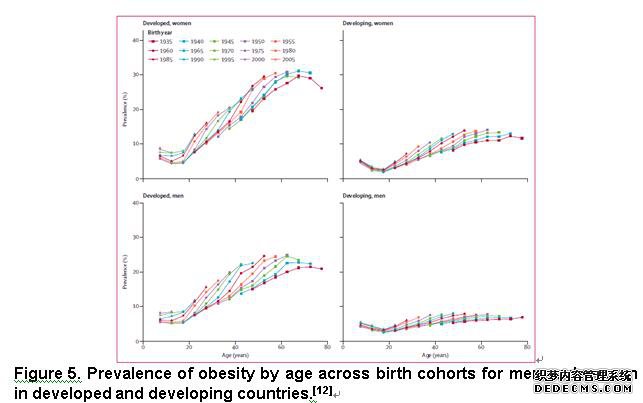
It is not surprising that inhibiting the intensification of type 2 diabetes in the context of developing countrieshas been agrowing challenge, partly because of its close relationship with obesity. According to the data from Wild et al.,[13]diabetes is rapidlymultiplying in magnitude as a worldwide health problem that might be advanced to a pandemic degree by 2030;the population with diabetes globally is predicted togo from 171 million at the start of the 21st centuryto 366 million in a 30-year timeframe (Figure 6).[14]
The increase may bemore prominentin developing countries, for example, India and China will facethe greatest impact. Inthese areas, the caustic reality of type 2 diabetesamong youngstersare also worseningwith anincredible speed, suggesting devastating consequences.[14]
In the developed country due to the better education on prevention of obesity and diabetes, the situation will be better than the developing country but still suffers more. Taking American as the first example, the cases of diabetes in 2030 will become 1.7 times of those in 2000, which actually will increase more greatly than Europe. One of the reasons may be the high-energy dietary habit of Americans. The second example is Australia, where has quite a small number (0.9 million) of diabetes in 2000. This may be due to the small population, life habit and genetic reasons. However, in 2030 the cases increase to 1.7 million which is almost 2 times of that in 2000. Without a doubt, in some developed country, obesity and diabetes are still an important public health issue.
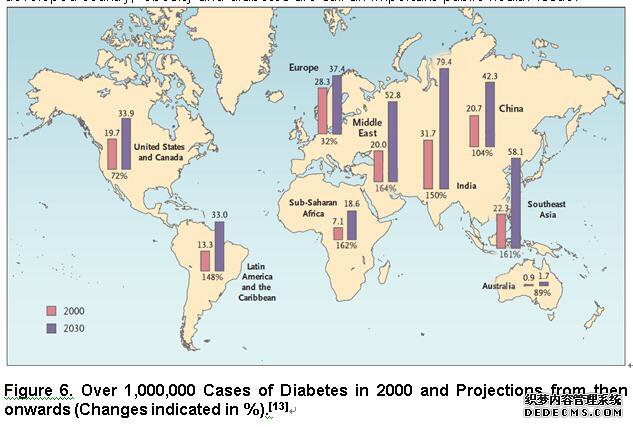
V. Prevention and Treatment of Type Two Diabetes
Knowing the conclusion that obesity has an intense link to the type 2 diabetes, the first task to prevent the type 2 diabetes is removing excess amount of fat.
Mostly,obesity is avoidable with the effort combined by personal habitsand social changes.By getting involved in the diabetes prevention program,[4] changing dietary habits and regular exercises are the principal treatments. Quality of diet can be ameliorated by decrease in consuming high-energy food, such as fatty and sugary materials, which can be replaced by a higher intake of dietary fiber. Medications might be more effective with a controlled diet that is formulated with the suitable principles. In case that the practices mentioned above all fail to provide ideal results, a gastric balloon or surgical process may be conducted to decrease the space inside the stomach or reduce the length of bowel, reducing the appetite of patients or cause a reduced degree innutrient absorption.
Regarding to the treatment of type 2 diabetes itself, besides controlling the weight, there are several points to be mentioned: 1) we can exploit the fundamental principles for the management of diabetesto help control the level of glucose(Table 2);[4] 2) to take physical activity not only‘exercise’, the former one is more general; 3) to take drug under the guidance of doctors since different drugs may be taken due to the considerations of antihypertensive treatment,anti-obesity in diabetic management and hyperglycaemia treatment; 4)to accept metabolic surgery.[4]
Table 2.Fundamental principles for the management of diabetes
VI. Conclusion
In this essay, the author firstly got a well recognition of the definition, history and causes of obesity and diabetes. Then the author moved the attention to the type 2 diabetes because it is the most typical type of diabetes, which can’t be simply treated by taking insulin. With the data and biological references, the author pointed out the fact that a highly positive correlation associating obesity and type 2 diabetes is observable.Comparing the current state of obesity and type two diabetes in two developed countries (American and Australia) and developing countries (China and India) using statistics and graphs,the author figured out a server situation of diabetes for developing countries in the future. Finally, a summary of tackling existing problems in patients and preventive measures of type 2 diabetes was given.
The author believed that the education of obesity and diabetes should be a long-term solution to make people changing their lifestyles to get rid of this two disease. Meanwhile, the global society should pay more attention to defeatingthis two epidemic disease: more education, more financial support and more research with more love and responsibility.
VII. Reference:
[1] Mantzoros, C. S. (2006). Obesity and diabetes. Springer Science & Business Media.
[2] Pollack, Andrew (June 18, 2013). "A.M.A. Recognizes Obesity as a Disease". New York Times. Archived from the original on June 18, 2013.
[3] Haslam DW, James WP (2005). "Obesity". Lancet (Review). 366 (9492): 1197–209.
[4] Barnett, T., & Kumar, S. (Eds.). (2009). Obesity and diabetes (Vol. 34). John Wiley & Sons.
[5]Ng, M., Fleming, T., Robinson, M., Thomson, B., Graetz, N., Margono, C., ... & Abraham, J. P. (2014). Global, regional, and national prevalence of overweight and obesity in children and adults during 1980–2013: a systematic analysis for the Global Burden of Disease Study 2013. The Lancet, 384(9945), 766-781.
[6] Bilous, R., & Donnelly, R. (2010). Handbook of diabetes. John Wiley & Sons.
[7] Guariguata, L., Whiting, D. R., Hambleton, I., Beagley, J., Linnenkamp, U., & Shaw, J. E. (2014). Global estimates of diabetes prevalence for 2013 and projections for 2035. Diabetes research and clinical practice, 103(2), 137-149.
[8] Holt, T., & Kumar, S. (2015). ABC of Diabetes. John Wiley & Sons.
[9] West, K. (1978) Epidemiology of Diabetes and its Vascular Lesions, Elsevier, New York.
[10]Steppan, C. M., Bailey, S. T., Bhat, S., Brown, E. J., Banerjee, R. R., Wright, C. M., ... & Lazar, M. A. (2001). The hormone resistin links obesity to diabetes. Nature, 409(6818), 307-312.
[11]Sattar, N., & Gill, J. M. (2014). Type 2 diabetes as a disease of ectopic fat?. BMC medicine, 12(1), 123.
[12]Ng, M., Fleming, T., Robinson, M., Thomson, B., Graetz, N., Margono, C., ... & Abraham, J. P. (2014). Global, regional, and national prevalence of overweight and obesity in children and adults during 1980–2013: a systematic analysis for the Global Burden of Disease Study 2013. The Lancet, 384(9945), 766-781.
[13] Rathmann, W., & Giani, G. (2004). Global prevalence of diabetes: estimates for the year 2000 and projections for 2030. Diabetes care, 27(10), 2568-2569.#p#分页标题#e#
[14] Hossain, P., Kawar, B., & El Nahas, M. (2007). Obesity and diabetes in the developing world—a growing challenge. N Engl j med, 2007(356), 213-215.
[15]Aguiree, F., Brown, A., Cho, N. H., Dahlquist, G., Dodd, S., Dunning, T., ... & Scott, C. (2013). IDF diabetes atlas.
|
 |
|||
| 网站地图 |

